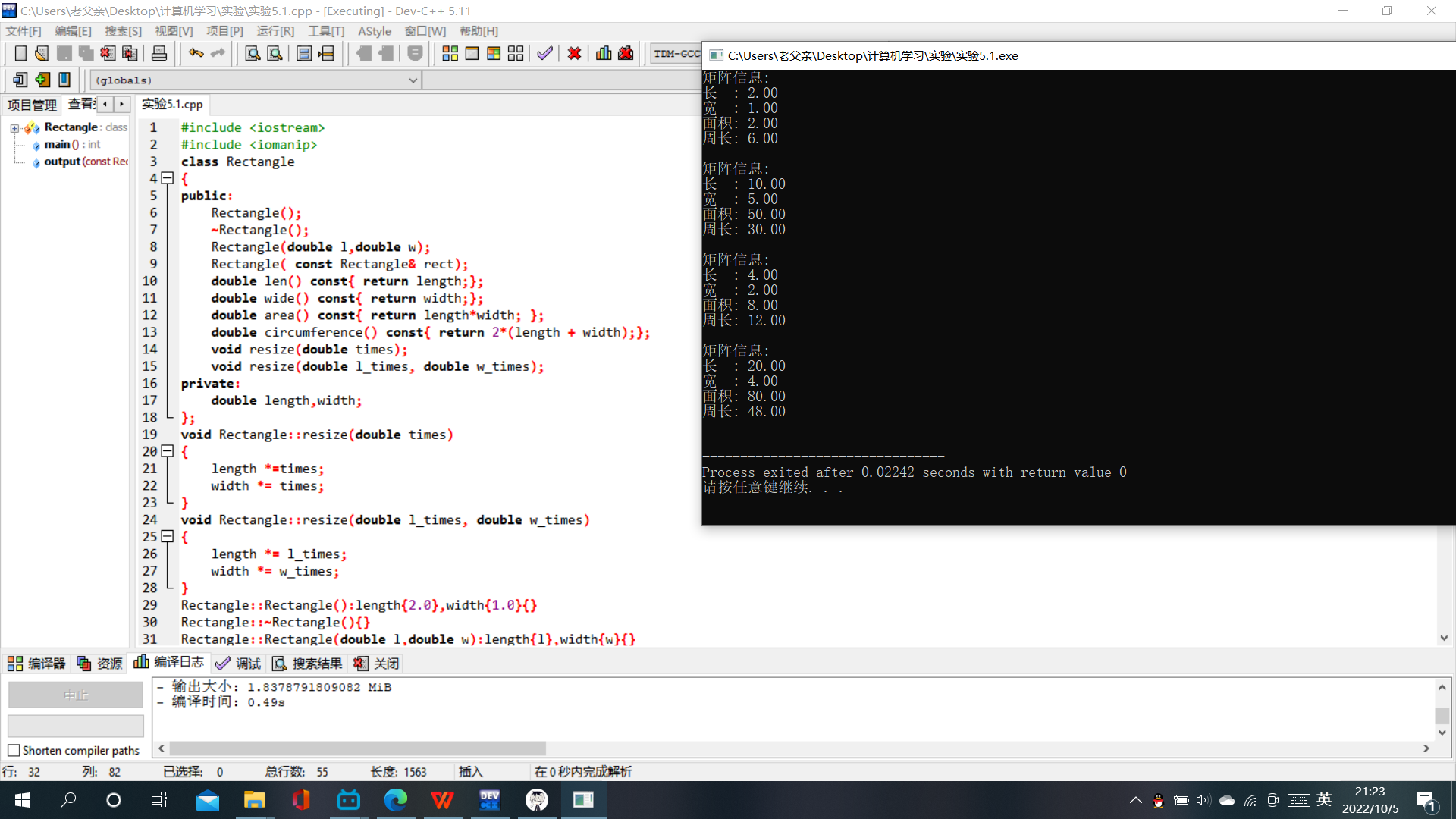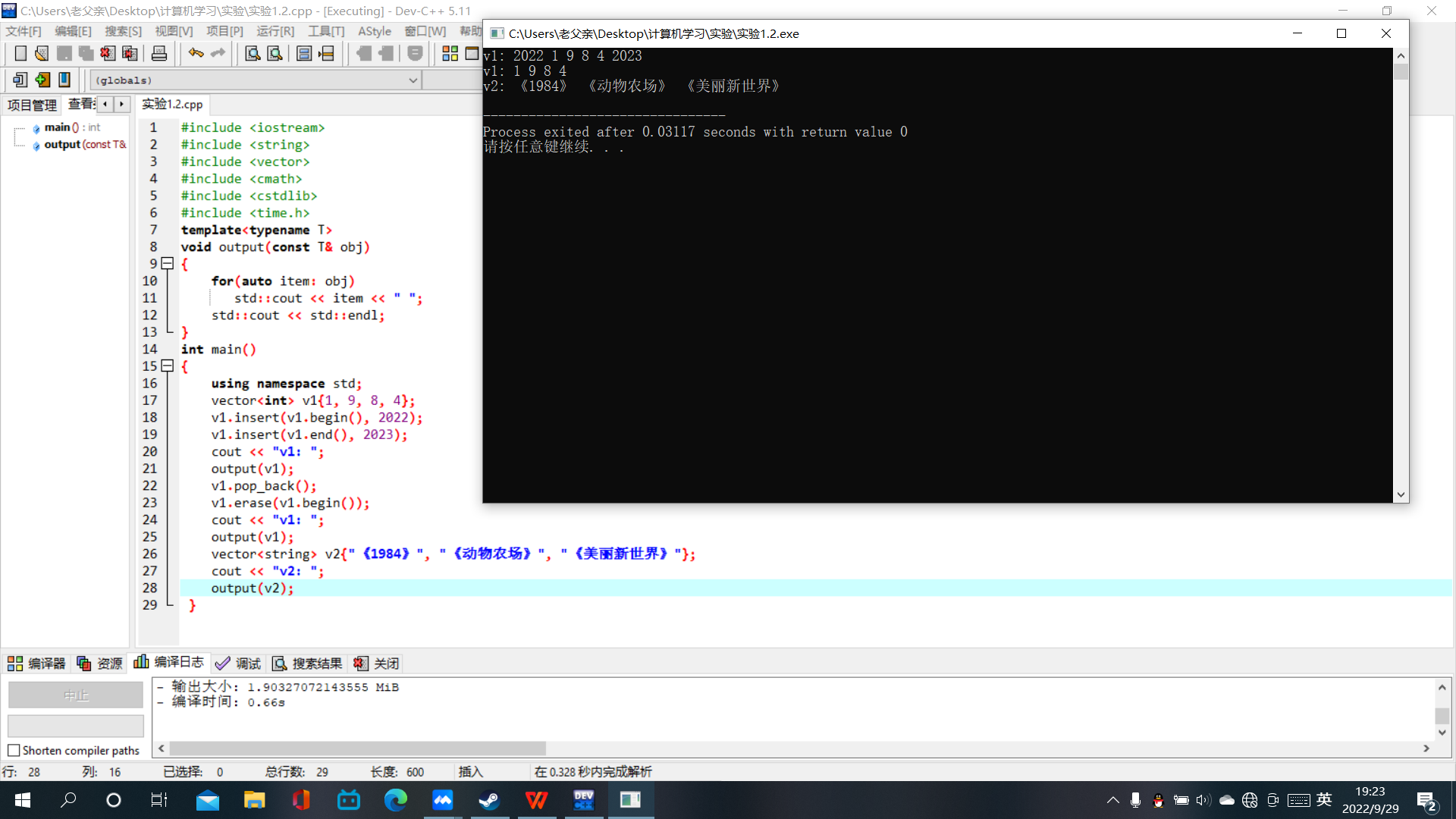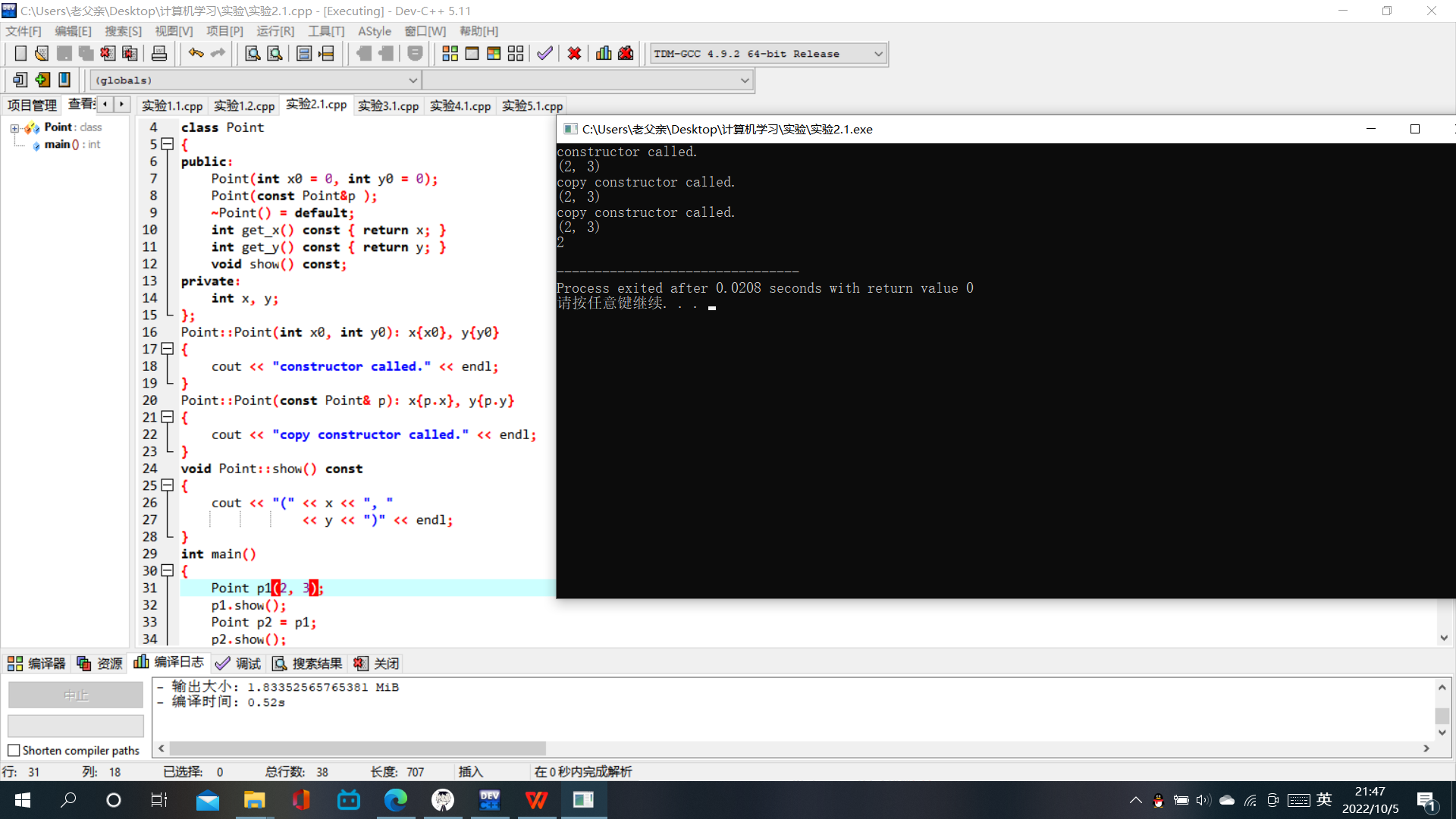实验1 类和对象(1)
实验五
#include <iostream> #include <iomanip> class Rectangle { public: Rectangle(); ~Rectangle(); Rectangle(double l,double w); Rectangle( const Rectangle& rect); double len() const{ return length;}; double wide() const{ return width;}; double area() const{ return length*width; }; double circumference() const{ return 2*(length + width);}; void resize(double times); void resize(double l_times, double w_times); private: double length,width; }; void Rectangle::resize(double times) { length *=times; width *= times; } void Rectangle::resize(double l_times, double w_times) { length *= l_times; width *= w_times; } Rectangle::Rectangle():length{2.0},width{1.0}{} Rectangle::~Rectangle(){} Rectangle::Rectangle(double l,double w):length{l},width{w}{} Rectangle::Rectangle(const Rectangle& rect):length{rect.length},width{rect.width}{} void output( const Rectangle &rect) { using namespace std; cout << "矩阵信息: \n"; cout <<"长 : "<< fixed << setprecision(2)<< rect.len() << endl; cout <<"宽 : "<< fixed << setprecision(2)<< rect.wide() << endl; cout <<"面积: "<< fixed << setprecision(2)<< rect.area() << endl; cout <<"周长: "<< fixed << setprecision(2)<< rect.circumference() << endl; cout << endl; } int main() { Rectangle rect1; output(rect1); Rectangle rect2(10, 5); output(rect2); Rectangle rect3(rect1); rect3.resize(2); output(rect3); rect3.resize(5, 2); output(rect3); }

实验一(1)
#include <iostream> #include <string> #include <vector> int main() { using namespace std; string s1; string s2{"c plus plus"}; string s3{s2}; string s4=s2; s1="oop"; vector<string> v1; v1.push_back(s1); v1.push_back(s2 + "1"); v1.push_back(s3 + "2"); v1.push_back(s4 + "3"); cout << "output1: " << endl; for(auto item: v1) cout << item << endl; cout << "ouput2: "; for(auto p = v1.begin(); p != v1.end(); ++p) cout << *p << endl; cout << "output3: " << endl; for(auto i = 0; i < v1.size(); ++i) cout << v1[i] << endl; vector<string> v2{v1.rbegin(), v1.rend()}; cout << "v2: " << endl; for(auto item: v2) cout << item << endl; }

实验一(2)
#include <iostream> #include <string> #include <vector> #include <cmath> #include <cstdlib> #include <time.h> template<typename T> void output(const T& obj) { for(auto item: obj) std::cout << item << " "; std::cout << std::endl; } int main() { using namespace std; vector<int> v1{1, 9, 8, 4}; v1.insert(v1.begin(), 2022); v1.insert(v1.end(), 2023); cout << "v1: "; output(v1); v1.pop_back(); v1.erase(v1.begin()); cout << "v1: "; output(v1); vector<string> v2{"《1984》", "《动物农场》", "《美丽新世界》"}; cout << "v2: "; output(v2); }

实验二
#include <iostream> using std::cout; using std::endl; class Point { public: Point(int x0 = 0, int y0 = 0); Point(const Point&p ); ~Point() = default; int get_x() const { return x; } int get_y() const { return y; } void show() const; private: int x, y; }; Point::Point(int x0, int y0): x{x0}, y{y0} { cout << "constructor called." << endl; } Point::Point(const Point& p): x{p.x}, y{p.y} { cout << "copy constructor called." << endl; } void Point::show() const { cout << "(" << x << ", " << y << ")" << endl; } int main() { Point p1(2, 3); p1.show(); Point p2 = p1; p2.show(); Point p3{p2}; p3.show(); cout << p3.get_x() << endl; }

实验三
#include <iostream> #include <iomanip> using std::cout; using std::endl; class Clock { public: Clock(int h = 0, int m = 0, int s = 0); Clock(const Clock& t); ~Clock() = default; void set_time(int h, int m = 0, int s = 0); void show_time() const; private: int hour, minute, second; }; Clock::Clock(int h, int m, int s): hour{h}, minute{m}, second{s} { cout << "constructor called" << endl; } Clock::Clock(const Clock& t): hour{t.hour}, minute{t.minute}, second{t.second} { cout << "copy constructor called" << endl; } void Clock::set_time(int h, int m, int s) { hour = h; minute = m; second = s; } void Clock::show_time() const { using std::setw; using std::setfill; cout << setfill('0') << setw(2) << hour << ":" << setw(2) << minute << ":" << setw(2) << second << endl; } Clock reset() { return Clock(0, 0, 0); } int main() { Clock c1(12, 0, 5); c1.show_time(); c1 = reset(); c1.show_time(); Clock c2(c1); c2.set_time(6); c2.show_time(); }

实验四
#include <iostream> class X { public: X(); ~X(); X(int m); X(const X& obj); X(X&& obj) noexcept; void show() const; private: int data; }; X::X(): data{42} { std::cout << "default constructor called.\n"; } X::~X() { std::cout << "destructor called.\n"; } X::X(int m): data{m} { std::cout << "constructor called.\n"; } X::X(const X& obj): data{obj.data} { std::cout << "copy constructor called.\n"; } X::X(X&& obj) noexcept: data{obj.data} { std::cout << "move constructor called.\n"; } void X::show() const { std::cout << data << std::endl; } int main() { X x1; x1.show(); X x2{2049}; x2.show(); X x3{x1}; x3.show(); X x4{ std::move(x2) }; x4.show(); }

x1调用了默认构造函数;
x2调用构造函数;
x3调用复制构造函数;
x4调用移动构造函数
析构函数最后调用,之后对x1,x2,x3,x4进行销毁。



 浙公网安备 33010602011771号
浙公网安备 33010602011771号